Maruti Suzuki
Maruti Suzuki India Limited, formerly known as Maruti Udyog Limited, is an automobile manufacturer in India. It is a 56.21% owned subsidiary of the Japanese automotive manufacturer Suzuki Motor Corporation.[7] As of July 2018, it had a market share of 53% of the Indian passenger car market.[8] The company is headquartered at New Delhi.[2]
 | |
Formerly | Maruti Udyog Limited |
|---|---|
| Public | |
| Traded as | |
| ISIN | INE585B01010 |
| Industry | Automotive |
| Founded | 1981[1] |
| Founder | Government of India |
| Headquarters | New Delhi, India[2] |
Area served | India |
Key people |
|
| Products | Automobiles |
Production output | |
| Revenue | |
| Total assets | |
| Total equity | |
Number of employees | 40,000 (2019)[5] |
| Parent |
|
| Website | www |
History
Maruti Udyog Limited was founded by the government of India in 24 February 1981,[10] only to merge with the Japanese automobile company Suzuki in October 1982. The first manufacturing factory of Maruti was established in Gurugram, Haryana, in the same year.[11]
Chronology
- Affiliation with Suzuki
In 1982, a license and joint venture agreement (JVA) was signed between Maruti Udyog Ltd., and Suzuki of Japan. At first, Maruti Suzuki was mainly an importer of cars. In India's closed market, Maruti received the right to import 40,000 fully built-up Suzuki in the first two years, and even after that the early goal was to use only 33% indigenous parts. This upset the local manufacturers considerably. There were also some concerns that the Indian market was too small to absorb the comparatively large production planned by Maruti Suzuki, with the government even considering adjusting the petrol tax and lowering the excise duty in order to boost sales.[12] Local production commenced in December 1983.[13] In 1984, the Maruti Van with the same three-cylinder engine as the 800 was released and the installed capacity of the plant in Gurgaon reached 40,000 units.
In 1985, the Suzuki SJ410-based Gypsy, a 970 cc 4WD off-road vehicle, was launched. In 1986, the original 800 was replaced by an all-new model of the 796 cc hatchback Suzuki Alto (SS80) and the 100,000th vehicle was produced by the company.[14] In 1987, the company started exporting to western markets, when a lot of 500 cars were sent to Hungary. By 1988, the capacity of the Gurgaon plant was increased to 100,000 units per annum.
- Market liberalisation
In 1989, the Maruti 1000 was introduced and the 970 cc, three-box was India's first contemporary sedan. By 1991, 65 percent of the components, for all vehicles produced, were indigenized. After liberalization of the Indian economy in 1991, Suzuki increased its stake in Maruti to 50 percent, making the company a 50-50 joint venture with the government of India as the other stake holder.
In 1993, the Zen, a 993 cc engined hatchback was launched and in 1994 the 1,298 cc Esteem sedan was introduced. Maruti produced its 1 millionth vehicle since the commencement of production in 1994. Maruti's second plant was opened with annual capacity reaching 200,000 units. Maruti launched a 24-hour emergency on-road vehicle service. In 1998, the new Maruti 800 was released, being the first change in design since 1986. Zen D, a 1,527 cc diesel hatchback, and Maruti's first diesel vehicle, and a redesigned Omni were introduced. In 1999, the 1.6-litre Maruti Baleno three-box sedan and Wagon R were also launched.
In 2000, Maruti became the first car company in India to launch a call center for internal and customer services. The new Alto model was released. In 2001, Maruti True Value, selling and buying used cars was launched. In October of the same year the Maruti Versa was launched. In 2002, Esteem Diesel was introduced. Two new subsidiaries were also started: Maruti Insurance Distributor Services and Maruti Insurance Brokers Limited. Suzuki Motor Corporation increased its stake in Maruti to 54.2 per cent.
In 2003, the new Suzuki Grand Vitara XL-7 was introduced while the Zen and the Wagon R were upgraded and redesigned. The four millionth Maruti vehicle was built and they entered into a partnership with the State Bank of India. Maruti Udyog Ltd. was listed on BSE and NSE after a public issue, which was oversubscribed tenfold. In 2004, the Alto became India's best selling car overtaking the Maruti 800 after nearly two decades. The five-seater Versa 5-seater, a new variant, was created while the Esteem was re-launched. Maruti Udyog closed the financial year 2003–04 with an annual sale of 472,122 units, the highest ever since the company began operations and the fiftieth lakh (5 millionth) car rolled out in April 2005. The 1.3-litre Suzuki Swift five-door hatchback was introduced in 2005.[15]
In 2006 Suzuki and Maruti set up another joint venture, "Maruti Suzuki Automobiles India", to build two new manufacturing plants, one for vehicles and one for engines.[15] Cleaner cars were also introduced, with several new models meeting the new Bharat Stage III emission standards.[15] In February 2012, Maruti Suzuki sold its ten millionth vehicle in India.[13] In July 2014 it had a market share of more 45%.[16] In May 2015, the company produced its fifteen millionth vehicle in India, a Swift Dzire.[17]
On 25 April 2019, Maruti Suzuki announced that it would phase out production of diesel cars by 1 April 2020, when the Bharat Stage VI emission standards come into effect. The new standards would require a significant investment from the company to upgrade its existing diesel engines to comply with the more stringent emission standards. Chairman R.C. Bhargava stated, "We have taken this decision so that in 2022 we are able to meet the corporate average fuel efficiency (CAFE) norms and higher share of CNG vehicles will help us comply with the norms. I hope the union government's policies will help grow the market for CNG vehicles." Diesel cars accounted for about 23 percent of Maruti Suzuki's annual sales.[18]
Joint venture related issues
Relationship between the Government of India, under the United Front (India) coalition and Suzuki Motor Corporation over the joint venture was a point of heated debate in the Indian media until Suzuki Motor Corporation gained the controlling stake. This highly profitable joint venture that had a near monopolistic trade in the Indian automobile market and the nature of the partnership built up till then was the underlying reason for most issues. The success of the joint venture led Suzuki to increase its equity from 26% to 40% in 1987, and to 50% in 1992, and further to 56.21% as of 2013.[19] In 1982, both the venture partners entered into an agreement to nominate their candidate for the post of Managing Director and every Managing Director would have a tenure of five years.[20][21]
Manufacturing facilities
Maruti Suzuki has two manufacturing facilities in India.[22] All manufacturing facilities have a combined production capacity of 1,200,000 vehicles annually. The Gurgaon manufacturing facility has three fully integrated manufacturing plants and is spread over 300 acres (1.2 km2).[23] The Gurgaon facilities also manufacture 240,000 K-Series engines annually. The Gurgaon facility manufactures the Alto 800, WagonR, Ertiga, XL6, S-Cross, Vitara Brezza, Ignis and Eeco.
The Manesar manufacturing plant was inaugurated in February 2007 and is spread over 600 acres (2.4 km2).[23] Initially it had a production capacity of 100,000 vehicles annually but this was increased to 300,000 vehicles annually in October 2008. The production capacity was further increased by 250,000 vehicles taking total production capacity to 800,000 vehicles annually.[24] The Manesar plant produces the Alto, Swift, Ciaz, Baleno and Celerio. On 25 June 2012, Haryana State Industries and Infrastructure Development Corporation demanded Maruti Suzuki to pay an additional Rs 235 crore for enhanced land acquisition for its Haryana plant expansion. The agency reminded Maruti that failure to pay the amount would lead to further proceedings and vacating the enhanced land acquisition.[25]
In 2017, the new Suzuki Motor Gujarat facility was opened. This third facility is not owned by Maruti Suzuki, but instead wholly owned by Suzuki Motor Corporation. Despite that, the plant supplied vehicles to Maruti without any additional cost. Located in Hansalpur, Ahmedabad, the plant has the total annual capacity of 500,000 units.[26][27]
In 2012, the company decided to merge Suzuki Powertrain India Limited (SPIL) with itself.[28] SPIL was started as a JV by Suzuki Motor Corp. along with Maruti Suzuki. It has the facilities available for manufacturing diesel engines and transmissions. The demand for transmissions for all Maruti Suzuki cars is met by the production from SPIL.
Industrial relations
Since its founding in 1983, Maruti Udyog Limited has experienced problems with its labour force. The Indian labour it hired readily accepted Japanese work culture and the modern manufacturing process. In 1997, there was a change in ownership, and Maruti became predominantly government controlled. Shortly thereafter, conflict between the United Front Government and Suzuki started. In 2000, a major industrial relations issue began and employees of Maruti went on an indefinite strike, demanding among other things, major revisions to their wages, incentives and pensions.[29][30]
Employees used slowdown in October 2000, to press a revision to their incentive-linked pay. In parallel, after elections and a new central government led by NDA alliance, India pursued a disinvestment policy. Along with many other government owned companies, the new administration proposed to sell part of its stake in Maruti Suzuki in a public offering. The worker's union opposed this sell-off plan on the grounds that the company will lose a major business advantage of being subsidised by the Government, and the union has better protection while the company remains in control of the government.[29][31]
The standoff between the union and the management continued through 2001. The management refused union demands citing increased competition and lower margins. The central government privatized Maruti in 2002 and Suzuki became the majority owner of Maruti Udyog Limited.[32][33]
Manesar violence
On 18 July 2012, Maruti's Manesar plant was hit by violence. According to Maruti management, the production workers attacked supervisors and started a fire that killed company's General Manager of Human Resources Avineesh Dev and injured 100 other managers, including two Japanese expatriates. The workers also allegedly injured nine policemen.[34][35] However Maruti Suzuki Workers Union (MSWU) President Sam Meher alleged that management ordered 300 hired security guards to attack the workforce during the violence.[36] The incident is the worst-ever for Suzuki since the company began operations in India in 1983.[37]
Since April 2012, the Manesar union had demanded a three-fold increase in basic salary, a monthly conveyance allowance of ₹10,000, a laundry allowance of ₹3,000, a gift with every new car launch, and a house for every worker who wants one, or cheaper home loans for those who want to build their own houses.[38][39] According to the Maruti Suzuki Workers Union a supervisor had abused and made discriminatory comments to a low-caste worker, Jiya Lal.[40] These claims were denied by the company and the police.[35] Maruti said the unrest began, not over wage discussions, but after the workers' union demanded the reinstatement of Jiya Lal who had been suspended for allegedly beating a supervisor.[37] The workers claim harsh working conditions and extensive hiring of low-paid contract workers which are paid about $126 a month, about half the minimum wage of permanent employees.[40] On 27 June 2013, an international delegation from the International Commission for Labor Rights (ICLR) released a report alleging serious violations of the industrial right of workers by the Maruti Suzuki management.[41] Company executives denied harsh conditions and claim they hired entry-level workers on contracts and made them permanent as they gained experience.[38] Maruti employees currently earn allowances in addition to their base wage.[42]
The police, in its First Information Report (FIR), claimed on 21 July that Manesar violence is the result of a planned violence by a section of workers and union leaders and arrested 91 people.[43][44] Maruti Suzuki in its statement on the unrest,[45] announced that all work at the Manesar plant has been suspended indefinitely.[37] The shut down of Manesar plant is leading to a loss of about Rs 75 crore[46] per day.[47] On 21 July 2012, citing safety concerns, the company announced a lockout under The Industrial Disputes Act, 1947 pending results of an inquiry the company has requested of the Haryana government into the causes of the disorder. Under the provisions of The Industrial Disputes Act for wages, the report claimed, employees are expected to be paid for the duration of the lockout.[46] On 26 July 2012, Maruti announced employees would not be paid for the period of lock-out in accordance with Indian labour laws. The company further announced that it will stop using contract workers by March 2013. The report claimed the salary difference between contract workers and permanent workers has been much smaller than initial media reports – the contract worker at Maruti received about ₹ 11,500 per month, while a permanent worker received about ₹12,500 a month at start, which increased in three years to ₹21,000-22,000 per month.[48] In a separate report, a contractor who was providing contract employees to Maruti claimed the company gave its contract employees[49] the best wage, allowances and benefits package in the region.[50]
Shinzo Nakanishi, managing director and chief executive of Maruti Suzuki India, said this type of violence has never happened in Suzuki Motor Corp's global operations in Hungary, Indonesia, Spain, Pakistan, Thailand, Malaysia, China and the Philippines. Nakanishi apologised to affected workers on behalf of the company, and in press interview requested the central and Haryana state governments to help stop further violence by legislating decisive rules to restore corporate confidence amid emergence of this new 'militant workforce' in Indian factories. He announced, "we are going to de-recognise Maruti Suzuki Workers' Union and dismiss all workers named in connection with the incident. We will not compromise at all in such instances of barbaric, unprovoked violence." He also announced Maruti plans to continue manufacturing in Manesar, that Gujarat was an expansion opportunity and not an alternative to Manesar.[51][52]
The company dismissed 500 workers accused of causing the violence and re-opened the plant on 21 August, saying it would produce 150 vehicles on the first day, less than 10% of its capacity. Analysts said that the shutdown was costing the company 1 billion rupees ($18 million) a day and costing the company market share.[53] In July 2013, the workers went on hunger strike to protest the continuing jailing of their colleagues and launched an online campaign to support their demands.[54]
A total of 148 workers were charged with the murder of Human Resources Manager Avineesh Dev. The court dismissed charges against 117 of the workers. On 17 March 2017, 31 workers were found guilty of variety of offences. 18 were convicted on charges of rioting, trespassing, causing hurt and other related offences under Indian Penal Code sections. The remaining 13 workers were sentenced to life in imprisonment after being found guilty of the murder of General Manager of Human Resources Avineesh Dev. Twelve of the thirteen sentenced were office-bearers of the Maruti Suzuki Workers Union at the time of the alleged offences. The prosecution had sought the death penalty for the thirteen.[55]
Both prosecution and defence have announced they will appeal against the sentences. Defence counsel Vrinda Grover stated, "We will file appeals against all convictions in the HC. The evidence, as it stands, cannot withstand legal scrutiny. There is no evidence to link these workers to the murder. The 13 who have been convicted, it’s important to remember that they were the leaders of the union. Therefore, it is clear that this is targeted framing of these persons. We hope for justice in the superior court".[56]
The Maruti Suzuki Workers Union is continuing to organise industrial action and protests calling for the workers to be released and criticising the judgement and sentences an unjust.[57] An international appeal for the release of the workers has been made by the International Committee for the Fourth International (ICFI) and other organisations such as the Peoples Alliance for Democracy and Secularism.[58][59]
Products and services
Current models
| Model | Production | Image | Outlet |
|---|---|---|---|
| Wagon R | 1999–present | .png) |
Arena |
| Alto | 2000–present | Arena | |
| Swift | 2005–present | 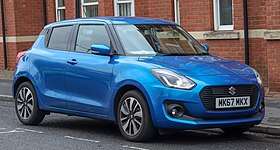 |
Arena |
| Ertiga | 2012–present | %2C_Batu_City.jpg) |
Arena |
| Celerio | 2014–present | 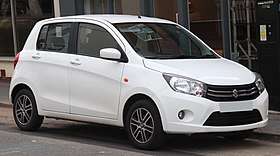 |
Arena |
| Ciaz | 2014–present | 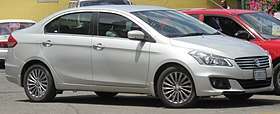 |
NEXA |
| Baleno | 2015–present | 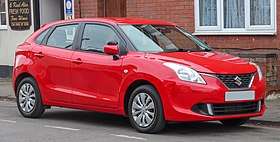 |
NEXA |
| S-Cross | 2015–present | 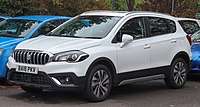 |
NEXA |
| Vitara Brezza | 2016–present | .jpg) |
Arena |
| Dzire | 2017–present | Arena | |
| Ignis | 2017–present | 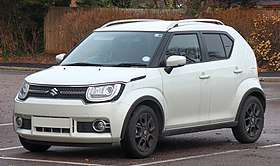 |
NEXA |
| XL6 | 2019–present | .jpg) |
NEXA |
| S-Presso | 2019–present | .jpg) |
Arena |
Discontinued models
| Model | Released | Discontinued | Image |
|---|---|---|---|
| 800 | 1983 | 2014 | 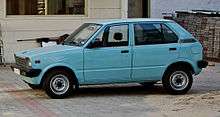 |
| Omni | 1984 | 2019 |  |
| Gypsy E | 1985 | 2000 | 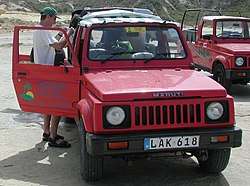 |
| Gypsy King | 1985 | 2017 | 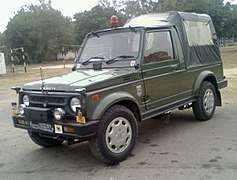 |
| 1000 | 1990 | 2000 | 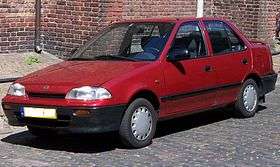 |
| Zen | 1993 | 2003 | 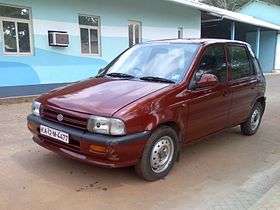 |
| Esteem | 1994 | 2010 | 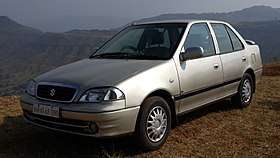 |
| Baleno | 1999 | 2007 | 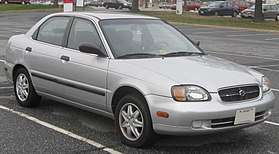 |
| Baleno Altura | 2000 | 2003 | |
| Alto | 2000 | 2012 | 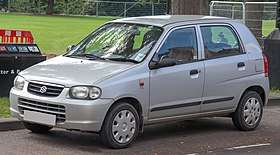 |
| Versa | 2001 | 2010 | |
| Grand Vitara XL7 (imported) |
2003 | 2007 | 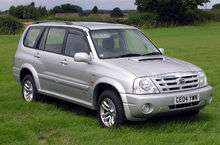 |
| Grand Vitara (imported) |
2007 | 2015 |  |
| Zen Estilo | 2007 | 2013 | |
| SX4 | 2007 | 2014 | 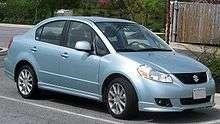 |
| A-star | 2008 | 2014 | .jpg) |
| Swift Dzire | 2008 | 2017 | .jpg) |
| Ritz | 2008 | 2016 | 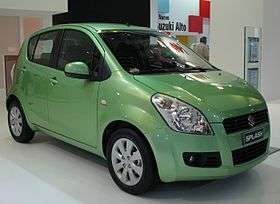 |
| Alto K10 | 2010 | 2020 | 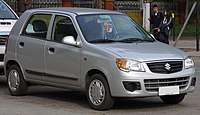 |
| Kizashi (imported) |
2011 | 2014 | 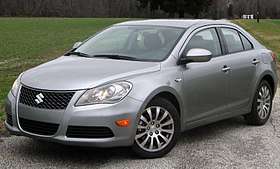 |
Sales and service network
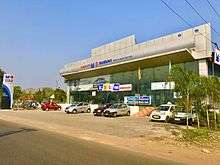
Maruti Suzuki has 3,598 sales outlets across 1,861 cities in India. The company aims to increase its sales network to 4,000 outlets by 2020.[60] It has 3,792 service stations across 1,861 cities throughout India.[61] Maruti's dealership network is larger than that of enough known companies combined.[62] Service is a major revenue generator of the company. Most of the service stations are managed on franchise basis, where Maruti Suzuki trains the local staff. Also, The Express Service stations exist, sending across their repair man to the vehicle if it is away from a normal service center.[63][64]
NEXA
In 2015, Maruti Suzuki launched NEXA, a new dealership network for its premium cars.[65]
Maruti currently sells the Baleno, S-Cross, XL6, Ciaz and Ignis through NEXA outlets.[66] S-Cross was the first car to be sold through NEXA outlets. Several new models will be added to both channels as part of the company's medium term goal of 2 million annual sales by 2020.[67]
Maruti Insurance
Launched in 2002 Maruti Suzuki provides vehicle insurance to its customers with the help of the National Insurance Company, Bajaj Allianz, New India Assurance and Royal Sundaram. The service was set up the company with the inception of two subsidiaries Maruti Insurance Distributors Services Pvt. Ltd and Maruti Insurance Brokers Pvt. Limited[68]
This service started as a benefit or value addition to customers and was able to ramp up easily. By December 2005 they were able to sell more than two million insurance policies since its inception.[69]
Maruti Finance
To promote its bottom line growth, Maruti Suzuki launched Maruti Finance in January 2002. Prior to the start of this service Maruti Suzuki had started two joint ventures Citicorp Maruti and Maruti Countrywide with Citi Group and GE Countrywide respectively to assist its client in securing loan.[70] Maruti Suzuki tied up with ABN Amro Bank, HDFC Bank, ICICI Limited, Kotak Mahindra, Standard Chartered Bank, and Sundaram to start this venture including its strategic partners in car finance. Again the company entered into a strategic partnership with SBI in March 2003[71] Since March 2003, Maruti has sold over 12,000 vehicles through SBI-Maruti Finance. SBI-Maruti Finance is currently available in 166 cities across India.[72]
Citicorp Maruti Finance Limited is a joint venture between Citicorp Finance India and Maruti Udyog Limited its primary business stated by the company is "hire-purchase financing of Maruti Suzuki vehicles". Citi Finance India Limited is a wholly owned subsidiary of Citibank Overseas Investment Corporation, Delaware, which in turn is a 100% wholly owned subsidiary of Citibank N.A. Citi Finance India Limited holds 74% of the stake and Maruti Suzuki holds the remaining 26%.[73] GE Capital, HDFC and Maruti Suzuki came together in 1995 to form Maruti Countrywide. Maruti claims that its finance program offers most competitive interest rates to its customers, which are lower by 0.25% to 0.5% from the market rates.[74]
Maruti TrueValue
Maruti True service offered by Maruti Suzuki to its customers. It is a market place for used Maruti Suzuki Vehicles. One can buy, sell or exchange used Maruti or non-Maruti vehicles with the help of this service in India. As of 10 August 2017 there are 1,190 outlets across 936 cities.[75]
N2N Fleet Management
N2N is the short form of End to End Fleet Management and provides lease and fleet management to corporates. Clients who have signed up of this service include Gas Authority of India Ltd, DuPont, Reckitt Benckiser, Doordarshan, Singer India, National Stock Exchange of India and Transworld. This fleet management service include Leasing, Maintenance, Convenience services and Remarketing.[76]
Maruti Accessories
Many of the auto component companies except than Maruti Suzuki started to offer compatible components and accessories. This caused a serious threat and loss of revenue to Maruti Suzuki. Maruti Suzuki started a new initiative under the brand name Maruti Genuine Accessories to offer accessories like alloy wheels, body cover, carpets, door visors, fog lamps, stereo systems, seat covers and other car care products. These products are sold through dealer outlets and authorized service stations throughout India.[77]
Maruti Driving School
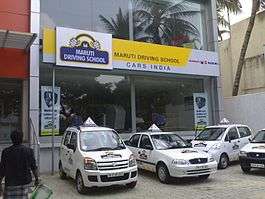
As part of its corporate social responsibility Maruti Suzuki launched the Maruti Driving School in Delhi. Later the services were extended to other cities of India as well. These schools are modelled on international standards, where learners go through classroom and practical sessions. Many international practices like road behaviour and attitudes are also taught in these schools. Before driving actual vehicles participants are trained on simulators.[78]
At the launch ceremony for the school Jagdish Khattar stated "We are very concerned about mounting deaths on Indian roads. These can be brought down if government, industry and the voluntary sector work together in an integrated manner. But we felt that Maruti should first do something in this regard and hence this initiative of Maruti Driving Schools."[79]
Awards and recognition
The Brand Trust Report published by Trust Research Advisory, a brand analytics company, has ranked Maruti Suzuki in the thirty seventh position in 2013[80] and ninth position in 2019[81] among the most trusted brands of India.
References and notes
- Aulbur, Wilfried. "Suzuki drives India's car manufacturing story". @businessline.
- "Office Addresses - Maruti Suzuki India Limited". Official Website of Maruti Suzuki. Retrieved 13 September 2018.
- "Our Leadership - Maruti Suzuki India Limited". www.marutisuzuki.com.
- "Maruti Suzuki 2018-19". Maruti Suzuki Limited.
- Maruti Udyog Ltd. Company Profile
- "Suzuki Motor's stake in Maruti Suzuki goes up to 56.21%". Livemint. 1 April 2013.
- Maruti Suzuki Corporate Information Archived 26 January 2013 at the Wayback Machine. Retrieved 2013-02-01.
- Mukherjee, Sharmistha (8 February 2020). "Maruti Suzuki grabs 53% of passenger vehicle market in January". The Economic Times. Retrieved 10 May 2020.
- "Maruti Suzuki India Ltd". Business Standard India. Retrieved 14 July 2020.
- "Latest Maruti Company Update". Marutisuzuki.com. Archived from the original on 15 May 2013. Retrieved 15 June 2012.
- B M (18 September 1982). "Message of Maruti-Suzuki". Economic and Political Weekly. Mumbai, India: Sameeksha Trust. XVII (38): 1524–1525.
- "Maruti's domestic sales crosses 1 cr mark". The Indian Express. Retrieved 9 February 2012.
- "The Maruti Udyog official Website Timeline Page". Archived from the original on 12 October 2007.
- "Maruti Udyog: Smooth Drive". Economic and Political Weekly. Mumbai, India: Sameeksha Trust. XLI (8): 672. 25 February 2006.
- "July 2014 : Indian Car Sales Figures & Analysis - Team-BHP". Retrieved 28 June 2016.
- "Maruti Suzuki rolls out 15 million cars | Team-BHP". Team-BHP.com. Retrieved 10 May 2020.
- Ghosh, Malyaban (25 April 2019). "Maruti to phase out all diesel cars from April next year". Mint. Retrieved 26 April 2019.
- "The Times of India". 1 April 2013.
- "Rediff on the Net: A successful marriage goes to court", 19 September 1997
- "Rediff". Rediff.com. 3 September 1997. Retrieved 10 October 2010.
- "Facilities". Marutisuzuki.com. Retrieved 10 October 2010.
- "How Maruti bounced back after its labour strife of 2012". www.businesstoday.in.
- "Archived copy". Archived from the original on 25 February 2015. Retrieved 24 February 2015.CS1 maint: archived copy as title (link)
- "Haryana government asks Maruti to pay Rs 235 crore for farmer compensation". The Economic Times. 24 July 2012.
- PTI (31 May 2016). "Suzuki Motor Gujarat plant will be operational from 2017: Osamu Suzuki". Livemint. Retrieved 2 June 2020.
- DelhiJanuary 31, India Today Web Desk New; January 31, 2017UPDATED:; Ist, 2017 16:01. "Production at Suzuki's Gujarat plant to begin from February 1". India Today. Retrieved 2 June 2020.CS1 maint: extra punctuation (link) CS1 maint: numeric names: authors list (link)
- "Maruti to merge Suzuki Powertrain with itself; Suzuki to increase stake to 56.21%". Retrieved 13 July 2016.
- U.C. Mathur (2010). Retail Management: Text And Cases. pp. 471–472. ISBN 978-9380578668.
- "Maruti staff to continue strike". The Hindu Business Line. 28 September 2000. Archived from the original on 19 February 2014.
- "MUL union leaders on hunger strike". The Hindu Business Line. 19 December 2000. Archived from the original on 25 January 2013.
- "Article Timeline of Maruti Suzuki Labour Unrest, World History Archive". Hartford-hwp.com. Retrieved 10 October 2010.
- "Maruti disinvestment - Releasing the clutch". The Hindu Business Line. 19 May 2002.
- Nikhil Gulati and Santanu Choudhury (19 July 2012). "Riot Hits Big India Auto Maker". The Wall Street Journal.
- Nikhil Gulati (22 July 2012). "Indian Car Maker Declares Lockout".
- PTI. "Violence has implications beyond one company, region: Maruti". The Hindu. Retrieved 26 February 2017.
- Santanu Choudhury (20 July 2012). "Maruti Manager Died in Fire After Limbs Broken". The Wall Street Journal.
- Vikas Bajaj; Sruthi Gottipati (19 July 2012). "Clash at an Auto Plant in India Turns Deadly". The New York Times. Retrieved 20 July 2012.
- "Maruti's Manesar plant GM(HR) burned to death, 91 workers arrested; government says business confidence intact". 19 July 2012.
- Ashok Sharma (21 July 2012). "India's Maruti Suzuki shuts riot-hit car plant". Huffington Post. Retrieved 23 July 2012.
- Ness, Immanuel (28 June 2013). "Violations of the Labor and Human Rights of Maruti Suzuki Workers in India". Labor and Working-Class History Association.
- Sumant Banerji (26 July 2012). "Maruti workers want lakh a month". The Hindustan Times. Archived from the original on 26 July 2012.
- Indo Asian News Service (21 July 2011). "Maruti violence may be planned: cops". New York Daily News. Archived from the original on 23 July 2012.
- "Police collect CCTV clips from Manesar MSIL plant". The Times of India. 21 July 2012.
- "Maruti Suzuki's statement on Manesar unrest". CNN-IBN. 19 July 2012.
- Chanchal Pal Chauhan (22 July 2012). "Maruti Suzuki declares lockout at Manesar factory". The Economic Times. Retrieved 21 July 2012.
- "Maruti's Manesar plant closed for third day, Rs 210cr loss so far". Retrieved 21 July 2012.
- "Maruti Suzuki to Stop Using Contract Workers in Direct Manufacturing". The Wall Street Journal. 26 July 2012.
- "Maruti Suzuki cuts 3,000 contract jobs". livemint.com. 27 August 2019. Retrieved 27 August 2019.
- "Violence at Maruti's Manesar plant: Bloodlust had taken over, eyewitness says". The Times of India. 26 July 2012.
- Chanchal Pal Chauhan (21 July 2012). "Maruti to stay put at Manesar, planning new plant". The Economic Times.
- Sharmistha Mukherjee & Surajeet Das Gupta (22 July 2012). "We will de-recognise Maruti Suzuki Workers' Union: Shinzo Nakanishi". Business Standard.
- The Times Colonist (21 August 2012). "Maruti Suzuki's riot-hit plant reopens but only at partial capacity". Archived from the original on 4 February 2013. Retrieved 22 August 2012.
- LabourStart (15 July 2013). "India: Free 147 jailed workers - support the hunger strikers". Retrieved 15 July 2013.
- "31 Maruti employees convicted for 2012 Manesar violence". Deccan Chronicle. 10 March 2017.
- Sakshi, Dayal (19 March 2017). "In Maruti plant violence: 13 sentenced to life, worker unions to hold rally". Indian Express.
- "Free the Maruti Workers! 13 Maruti Union members given 'Life Sentence' for Struggling for Union Formation &Abolition of the Contract Worker System". Maruti Suzuki Workers Union. 19 March 2017.
- "Free the framed-up Maruti Suzuki workers!". World Socialist Website. 20 March 2017.
- Rao, Battini. "Demanding Justice For Convicted Workers of Maruti Suzuki". Counter Currents.
- "Maruti aims to double sales network to 4,000 outlets by 2020". The Economic Times. 4 April 2016.
- "Maruti storage new". Retrieved 10 May 2020.
- "Maruti tops dealership charts with 1,800 outlets across 1,450 cities - Times of India". The Times of India.
- 5 Paise Stock Broking's report on Maruti Udyog Limited before the IPO (.pdf file) "Archived copy" (PDF). Archived from the original (PDF) on 19 February 2006. Retrieved 15 February 2006.CS1 maint: archived copy as title (link)
- "Archived copy". Archived from the original on 20 May 2012. Retrieved 24 July 2012.CS1 maint: archived copy as title (link)
- "Archived copy". Archived from the original on 8 October 2015. Retrieved 7 October 2015.CS1 maint: archived copy as title (link)
- Desk, Internet. "Ignis: a premium hatchback for millennials from Maruti". The Hindu. Retrieved 26 February 2017.
- https://marutistoragenew.blob.core.windows.net/nexaexperience/maruti-suzuki-launches-NEXA-a-new-premium-automotive-experience.pdf
- The Hindu Business:Saturday, 11 May 2002 - Maruti launches car insurance Archived 27 May 2005 at the Wayback Machine
- The Hindu Business Line Sunday, 18 December 2005 -Maruti Insurance ramps up sales Archived 29 September 2007 at the Wayback Machine
- "Maruti launches venture for car finance". 18 November 2004. Archived from the original on 18 November 2004.
- Business Line, Saturday, 15 March 2003, SBI ties up with Maruti Suzuki for car loans
- Retail Yatra. Com, 8 August 2003 -Maruti Suzuki, State Bank of Bikaner & Jaipur join hands for car financing Jaipur "Archived copy". Archived from the original on 9 October 2007. Retrieved 16 February 2006.CS1 maint: archived copy as title (link)
- The Hindu, Online edition of India's National Newspaper, Published: Thursday, 26 July 2001, Citicorp Maruti Finance gets P1 plus
- Jebin, Nujhat. "MARUTI Institutional Ownership - MARUTI SUZUKI INDIA LTD. Stock". fintel.io.
- "Maruti Suzuki to pep up True Value pre-owned car biz, plans revamp and expansion". Autocarpro.
- Writeup about the Maruti N2N Fleet Management Solution Archived 21 October 2006 at the Wayback Machine
- "Maruti Genuine Accessories". Archived from the original on 21 April 2005.
- Deccan Herald, Online edition of Sunday, 20 March 2007 "Maruti Suzuki's first driving school in Bangalore""Archived copy". Archived from the original on 27 March 2006. Retrieved 15 February 2006.CS1 maint: archived copy as title (link)
- Correspondent, Our Special (20 March 2005). "MUL sets up driving school in Bangalore". The Hindu – via www.thehindu.com.
- "India's Most Trusted Brands 2013". Archived from the original on 28 August 2013.
- "2019".